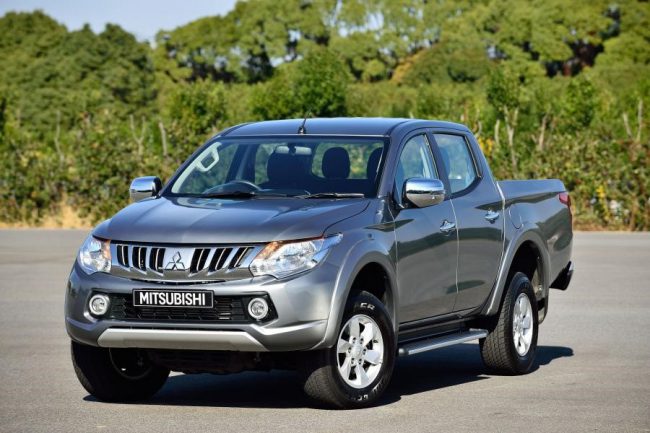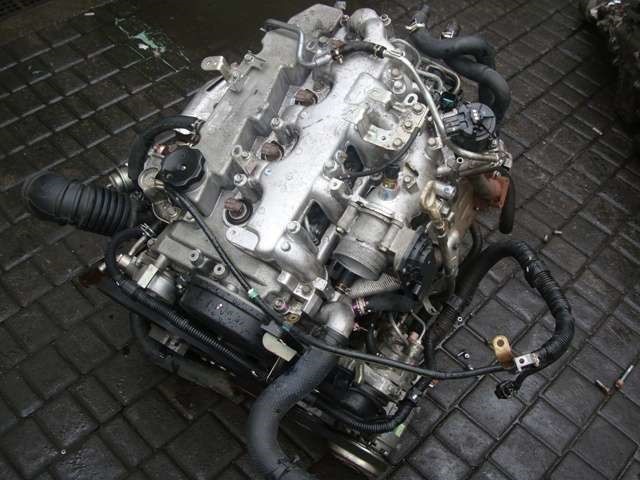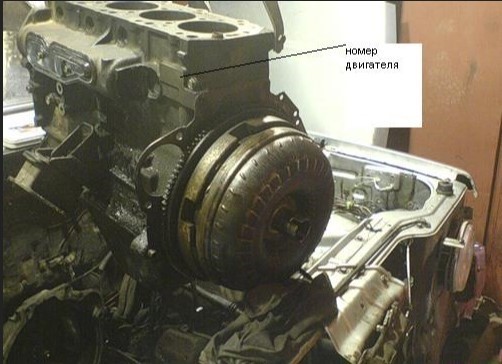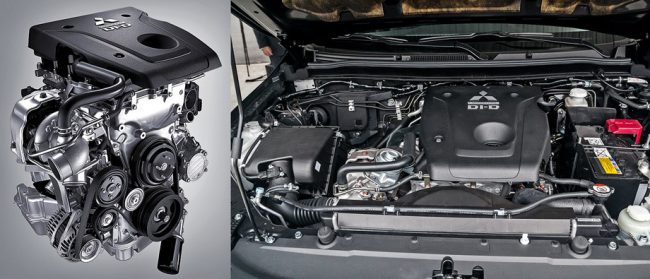
Mitsubishi L200 engines
Content
- Brief description and history of Mitsubishi L200
- All engines that were installed on the Mitsubishi L200
- The most common powertrains for the L200 in Russia
- Features of 4D56 engines, tuning and number location
- Possible malfunctions and problems of 4D56 engines
- Features of 4N15 engines and their main malfunctions
- Some rules for operating the 4N15 motor
- Engine selection
Mitsubishi L200 is a pickup truck produced by the Japanese company Mitsubishi Motors since 1978. In just 40 years, five generations of these cars have been created. Manufacturers from Japan managed to create a not quite standard pickup truck with smooth, rather than rectangular lines in the silhouette.
This ended up being a good move. And today, for example, in Russia Mitsubishi L200 is among the leaders in its segment. However, in addition to the original image, this car is also distinguished by the high reliability of components, in particular, engines.
Brief description and history of Mitsubishi L200
The first Mitsubishi L200 model was a small-sized rear-wheel drive pickup truck with a payload capacity of one ton. As a result of such trucks, more than 600000 copies were sold in a few years.
The second generation replaced the first in 1986. These models had a number of innovations, in particular, a double cab.
 The next generation entered the market after another ten years. The new L200 with all-wheel drive was perfect for both work and life in the country. They were really very practical, no frills, pickup trucks - reliable, passable and comfortable.
The next generation entered the market after another ten years. The new L200 with all-wheel drive was perfect for both work and life in the country. They were really very practical, no frills, pickup trucks - reliable, passable and comfortable.
IV generation models were produced from 2005 to 2015. Moreover, there were several variations with different cabins (two-door double, two-door four-seater, four-door five-seater). Depending on the configuration, IV generation cars were equipped with air conditioning, an audio system, a mechanical center differential lock, an ESP directional stability system, etc.
Sales of the fifth generation Mitsubishi L200 started in the Russian Federation, according to reports and videos on this topic in the media, in August 2015. This pickup was defined by the creators themselves as "an uncompromising sports utility truck." At the same time, it looks appropriate not only on the roads, but also in the conditions of the metropolis. These cars have retained the traditional proportions and characteristic curve at the transition to the body compartment. However, compared to the previous generation, they received a different design of the radiator grille, a different shape of bumpers, and different lighting equipment.
 In addition, much attention in the fifth generation L200 is paid to the convenience of the driver and passengers, the improvement of sound insulation, driving performance, and so on. It has already been noted that in terms of comfort, these cars are not much inferior to many passenger models.
In addition, much attention in the fifth generation L200 is paid to the convenience of the driver and passengers, the improvement of sound insulation, driving performance, and so on. It has already been noted that in terms of comfort, these cars are not much inferior to many passenger models.
All engines that were installed on the Mitsubishi L200
Over the forty-year history, both the appearance and the “insides” of this brand have undergone major changes and improvements. This, of course, also applies to engines. In the table below you can see all the power units that have been installed on this car since 1978.
| Generations of Mitsubishi L200 cars | Engine brands used |
|---|---|
| 5th generation (release time: from 08.2015 to our time) | |
| 4N15 | |
| 4th generation restyling | 4D56 |
| 4D56HP | |
| 4st generation | 4D56 |
| 3 generation restyling (release time: from 11.2005 to 01.2006) | 4D56 |
| 3rd generation (release time: from 02.1996 to 10.2005) | 4D56 |
| 4G64 | |
| 4D56 | |
| 2rd generation (release time: from 04.1986 to 01.1996) | 4D56T |
| 4G54 | |
| 6G72 | |
| G63B | |
| 4G32 | |
| 4G32B | |
| G63B | |
| 1 generation restyling (release time: from 01.1981 to 09.1986) | 4G52 |
| 4D55 | |
| 4D56 | |
| 4G54 | |
| 4G32 | |
| 4G32B | |
| 1rd generation (release time: from 03.1978 to 12.1980) | G63B |
| 4G52 | |
| 4D55 | |
| 4D56 | |
| 4G54 |
The most common powertrains for the L200 in Russia
Obviously, the most common in this case will be the engines that are installed on L200 cars of the third and all subsequent generations. Because the cars of the first two generations were not sold in the USSR and in Russia. And if they can be found in our country, it is still a rarity. Thus, the most common power plants on the territory of the Russian Federation in this case are:
- 4N15 engine for Mitsubishi L200 2.4 Di-D;
- various engine modifications
If we talk about fourth-generation L200 cars before restyling, then under their hood, Russian motorists can only see a 2.5-liter turbocharged engine with a capacity of 136 horsepower, running on a diesel engine. But after restyling, a new, more powerful, but the same volume (200 horsepower) 178D4HP turbodiesel made up a couple of L56s, and now motorists have a choice.
As for the 4N15, this four-cylinder diesel engine is essentially an upgraded version of the 4D56 engine, runs significantly quieter than its predecessor, and has good COXNUMX emissions.
For residents of the Russian Federation, L200 cars are offered with a 4N15 2.4 Di-D unit, capable of squeezing 181 hp. With. By the way, the presence in the marking of a combination of letters DI-D in the marking indicates that the engine is diesel, and it uses direct fuel mixture injection technology. But, for example, in Thailand, a version with a 2.4-liter gasoline naturally aspirated engine and a 2.5-liter turbocharged diesel engine is being sold.
Features of 4D56 engines, tuning and number location
| Technical specifications | Parameters |
|---|---|
| Engine capacity | 4D56 - 2476 cubic centimeters; |
| 4D56 HP - 2477 cc | |
| Engine type | In-line, four-cylinder |
| Fuel used | Diesel fuel |
| Number of valves per cylinder | 4 |
| Fuel consumption | Up to 8,7 liters per 100 kilometers |
| Maximum power | 4D56 - 136 hp at 4000 rpm; |
| 4D56 HP - 178 hp at 4000 rpm | |
| Maximum torque | 4D56 - 324 Newton meters at 2000 rpm; |
| 4D56 HP - 350 Newton meters at 3500 rpm |
The 4D56 engine block is traditionally cast iron, and the crankshaft is steel, five-bearing. The first version of this engine was developed by Mitsubishi specialists in 1986. And during this time, many of its modifications were created. Although now the era of this engine, of course, is coming to an end - its production has practically ceased.
4D56 motors for the IV generation Mitsubishi L200 (before and after restyling) with a volume of 2.5 liters are distinguished by:
- the absence of sleeves (this made it possible to reduce the number of elements within each block);
- more efficient cooling by increasing the diameter of the channels;
- the presence of modified pistons and valves made of refractory steel;
- the presence of high-quality protection of the engine from fuel detonation - such protection is provided by the displacement of the axis of the finger;
- ensuring high-quality swirling of the air flow in the cylinder head.
 If the technical characteristics and properties of the described engine do not suit the owner, he can try to do tuning. One of the most common solutions in this case is to install a special power increase unit in parallel with the "native" electronic unit. In addition, you can add power to the engine by installing a new turbine and changing some other components: a crankshaft, an oil pump, and so on.
If the technical characteristics and properties of the described engine do not suit the owner, he can try to do tuning. One of the most common solutions in this case is to install a special power increase unit in parallel with the "native" electronic unit. In addition, you can add power to the engine by installing a new turbine and changing some other components: a crankshaft, an oil pump, and so on.
All these decisions, of course, require a professional approach and prior consultation. If the engine is very old and worn out, then tuning is contraindicated for it.
And one more important topic: many are interested in exactly where the engine number 4D56 is located on the Russian Mitsubishi L200. It is not so easy to find it, but the task can be simplified if you remove the intercooler in advance. The number is engraved on a special rectangular protruding area closer to the left wing. This site is located at the level of the injection pump under the nozzles, more specifically, between the third and fourth nozzles. Knowing this number and its location can sometimes come in handy when communicating with traffic police officers.
Possible malfunctions and problems of 4D56 engines
It is worth describing at least a few of these faults:
- The turbine vacuum tube has lost its tightness, and the injection pump valve is clogged or worn out. This can lead to very serious engine failures. By the way, experts say that the injection pump on such cars must be changed every 200-300 thousand kilometers.
- The engine smokes too much and fuel consumption increases. In this case, it is worth checking and, if necessary, replacing the air filter or air flow sensor.
- The heater (stove) motor is clogged - rust and other deposits from the cast-iron engine block accumulate on its radiator. In the end, this can lead to the fact that the stove motor will completely fail on the L200 with cast-iron engines, this does not happen so rarely.
- In winter, the Mitsubishi L200 engine does not start or starts with big problems (for example, due to the fact that the car is in an unheated garage), in winter, its owner, for obvious reasons, may encounter a problem starting the engine. You can solve the problem by installing an additional device for heating the engine - the price of such heaters today is not so high.
- Vibration and knocking of the fuel appears: this problem occurs when the balancer belt breaks or stretches.
- The occurrence of leaks in the valve cover area. In such a situation, most likely, you just need to change the gasket of this cover. Head wear from exposure to high temperatures is rare for the 4D56.
Features of 4N15 engines and their main malfunctions
| Specifications 4N15 | |
|---|---|
| Engine capacity | 2442 cubic centimeters |
| engine's type | In-line, four-cylinder |
| Fuel used | Diesel fuel |
| Number of valves per cylinder | 4 |
| Fuel consumption | up to 8 liters per 100 kilometers |
| Maximum power | 154 HP or 181 hp at 3500 rpm (depending on modification) |
| Maximum torque | 380 or 430 Newton meters at 2500 rpm (depending on version) |
That is, there are two modifications of the 4N15 power units for the Mitsubishi L200. The base engine (with a maximum power of 154 hp) is equipped with a six-speed manual or five-speed automatic transmission with sequential sport mode, and a more productive 181-horsepower engine - only automatic. Which of these power units a motorist will see under the hood of a particular Mitsubishi L200 depends on the version and equipment of the car.
The 4N15 uses a lightweight aluminum cylinder block. And it was due to the use of aluminum that it became possible to optimize certain parameters. In principle, all modern aluminum internal combustion engines have the same advantages:
- low cost;
- immunity to a sharp change in temperature;
- ease of casting, cutting and reworking.
However, such engines also have disadvantages:
- insufficient rigidity and strength;
- increased load on the sleeves.
This motor operates in conjunction with two camshafts - this is the so-called DOHC system. The main ICE unit is powered by a Common Rail fuel system, which involves three-stage direct injection. The pressure inside the power system rises to two thousand bar, and the compression ratio is 15,5:1.
Some rules for operating the 4N15 motor
In order for this motor to serve its declared operational life, it is necessary to do the following:
- periodically update glow plugs (in this case, it is recommended to install strictly original candles);
- control the state of the timing drive;
- monitor the engine temperature sensor;
- in time to clean the nozzles, which in diesel engines quickly become clogged;
- carry out maintenance and diagnostics in official service centers.
The 4N15 diesel engine is equipped with a particulate filter, and therefore it needs a special oil - this is written in the instruction manual. In addition, it must have an SAE viscosity corresponding to the temperature. As an example of a suitable oil for this engine, one can name such compounds as Lukoil Genesis Claritech 5W-30, Unil Opaljet LongLife 3 5W-30 and so on.
An oil change should be made approximately every 7000-7500 kilometers. This procedure is quite simple, but you will still need some tools, such as a dipstick, with which you should check the oil level immediately after filling.
And every 100000 kilometers it is recommended to change the power steering fluid. And here it should be noted that an experienced driver always turns off the engine on his Mitsubishi L200 when changing the power steering fluid. Doing this procedure with the engine running is not recommended - this is fraught with additional problems.
Savings on fuel and oils, coupled with careless driving, can lead to an engine requiring unscheduled repairs. 4N15 complies with current European regulations, and therefore is quite sensitive to such things.
Engine selection
Engines on the latest generations of the Mitsubishi L200 are worthy and reliable units. The resource of such engines, according to motorists, can be more than 350000 kilometers. But if we are talking about a used car, then it is better, of course, to choose the option with the 4N15 engine - newer models with less age and mileage are equipped with it.
In general, a pickup truck is not the kind of transport that is operated in a sparing format. Many Mitsubishi L200 motorists, for example, 2006, are not in the best technical condition today, because they have experienced a lot of travel and adventures in the past.
As for buying a car with a 4D56 HP engine, this is also a good decision in principle. It is more powerful than the standard 4D56 version, and this is very important for a pickup truck that drives off-road. Even small differences in horsepower in this case are very felt.
If a potential buyer does not need a car completely, he can separately order a high-quality contract (that is, not used in Russia and the CIS) engine.

